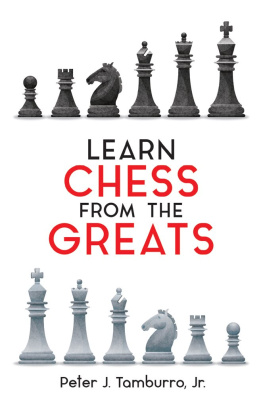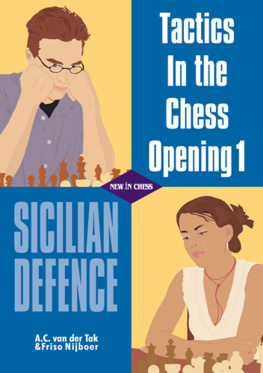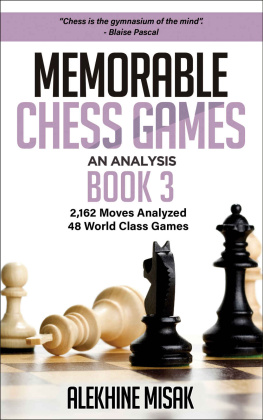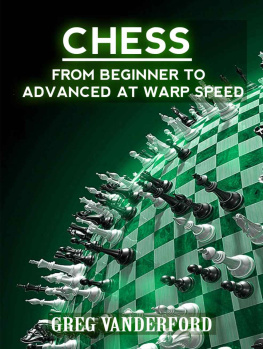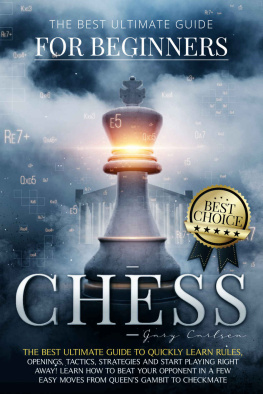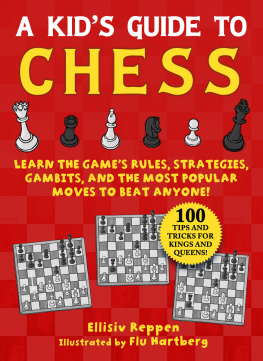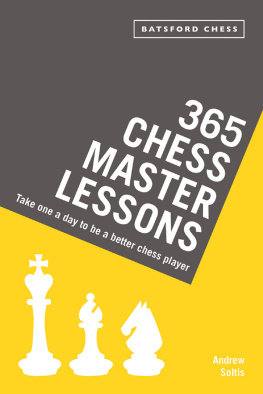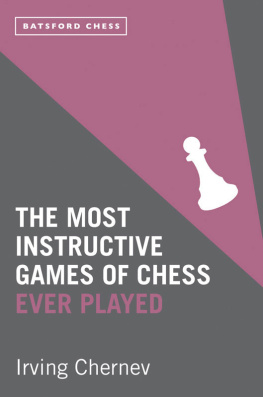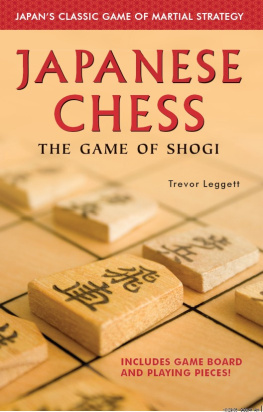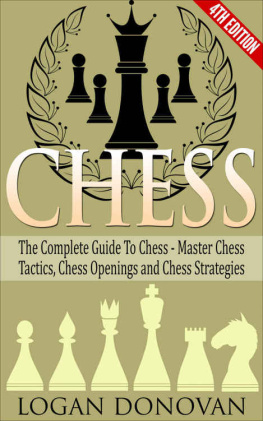LEARN
CHESS
FROM THE
GREATS
Peter J. Tamburro, Jr.
DOVER PUBLICATIONS, INC.
Mineola, New York
Copyright
Copyright 2000 by Peter J. Tamburro, Jr.
All rights reserved.
Bibliographical Note
Learn Chess from the Greats, first published in 2000 by Dover Publications, Inc., and reissued in 2016, is an original compilation of nationally syndicated newspaper columns distributed by The United States Chess Federation between 1994 and 1998.
Library of Congress Cataloging-in-Publication Data
Tamburro, Peter J.
Learn chess from the greats / Peter J. Tamburro, Jr.
p. cm.
Includes index.
ISBN-13: 978-0-486-41373-0 ISBN-10: 0-486-41373-X (pbk.)
1. Chess. 2. ChessCollections of games. I. Title.
GV1446 .T26 2000
794.1dc21
00060163
Manufactured in the United States
41373X03 2016
www.doverpublications.com
Acknowledgments
To Glenn Petersen, editor of Chess Life for asking the author to write a nationally syndicated column for the U.S. Chess Federation. To Fred Wilson for suggesting these columns would make a good book. To Riley Kellogg for making these columns come to life through her formatting expertise.
And to those magnificent authors before me who share the love of the artistry of chess: Fiske, Agnel, Loyd, Reinfeld, Chernev, Soltis, Assiac, Lauterbach, James and Fox, D. J. Morgan, Whyld, and C. J. S. Purdy. We learn from these greats, too.
Table of Contents
Introduction
There is a reason chess has survived as a popular game for over a millennium. Actually, there are two reasons!
First, chess is a wonderful mysterious puzzle to grandmaster and beginner alike. Chess is the type of mystery that allows you to solve parts of it, but never all of it. You can always learn from the game no matter who you are. The challenge is still there.
In the 1920s and 1930s, some grandmasters thought the game had pretty much been solved. They were wrong. The post World War II era created a new dynamic game that fascinated yet more generations. Computers will not kill chess either. Sure, they can calculate faster and further than we can. However, even these collections of nuts and bolts have their horizons beyond which they cannot see. Computers have, however, raised a challenge to the human species that needs to be met. Its our turn to solve another part of the great mystery that is chess.
Secondly, chess really is a lot of fun! The more you learn about chess, the more fun it is. Too many people have an image of a couple of elderly gentlemen, with cobwebs about them, hunched over a board. If you have ever been to one of those scholastic tournaments with hundreds, even thousands of kids, you are amazed at two things. First, the children can stay quiet for a very long period time. Second, when these youngsters are done with their tournament game they, alive with delight, play even more chess between roundsincluding the chaotic bughouse chess.
Of course, there is the quieter form of fun. Find a friend who is just about your strength and play regularly with that friend either at your homes or at a club. Or play with a perfect stranger at a club or in Washington Square Park in New York City and make a friend. The great fun of chess is not only its art and its beauty and its variations, but its human aspect. The bonds that are shared with other people because its a game you both love are crucial to the true enjoyment of the game.
My dad and my Uncle Bob used to play chess when we went to visit. They did not mind a curious seven-year-old watching the game. I was intrigued by the knight move. They were very patient teaching me the game. My uncle gave me a book by the British champion, Harry Golombek, and a Dover Publications collection of Morphys games. At home I eventually found a buddy who played. One summer we must have played a thousand games. I came to love the game for those very same two reasons. Every time I played or read I learned something. Fischers biographer, Frank Brady, once told me in an interview (www.correspondencechess/cja.com) that every time he played he felt his IQ went up a point. I felt that way, too.
Eventually, my group of chess playing friends expanded. I bought more books. I started playing in tournaments at fourteen. Chess had hooked me. Occasionally, it conflicted with other interests. Once, I had to explain to my high school basketball coach that I wouldnt make the team bus because I would be coming directly from playing in the New Jersey high school chess championship. I still remember his bemused expression.
When I attended Dickinson College to further my education, I became friends with another chess playerGlenn Petersen. We formed a rather formidable small college team (we even upset Georgetown). A few years later (1973) Glenn came to me with the idea of starting the Atlantic Chess News, which still exists today. Glenn has become the superb editor of Chess Life, which has won countless awards under his leadership.
One day, in the fall of 1994, he called to ask me to write the U.S. Chess Federations syndicated weekly chess column, which eventually came to be sent to almost 200 newspapers around the country. In 1995 the column was recognized by the Chess Journalists of America as the Best Regular Newspaper Column.
Because the months worth of columns had to be sent out at once, I realized that I could not be up to the minute. The purpose of the columns then became to instruct and entertain. It became a kind of mission in another sense. Since the changeover to algebraic, a good deal of wonderful chess has been lost. Old games that have not been converted to the new notation and books with descriptive notation do not often see the light of day.
I started scouring my libraryBritish Chess Magazine from 1920 to the present, Chess Review from the 1930s, C. J. S. Purdys Chess World from the 1940s on and several score of books on the enjoyment of chess. What a treasure trove! Reintroducing these old classics was my way of making sure a valuable heritage was not lost.
This book is meant to be your guide to learning and enjoying chess in an informal and user-friendly way. You will find the greats in hereFischer, Tal, Alekhine, Botvinnik, Lasker and many more. In addition to these acknowledged giants who have left a permanent and profound imprint on chess, there are others in here who have achieved a kind of greatness to which all of us can aspire.
As Fred Wilson, in his popular book 101 Questions On How to Play Chess, points out, anyone can create beauty in chess. Even amateurs have moments of greatness because chess does not judge you on what your pedigree is. It judges you on the moves you make. So, in this book, you will find the great, the near great, the momentarily great and the never were great; however, all these positions and games were chosen so you, the reader, could learn and enjoy the wide variety of treasures I have unearthed.
You see, I am a chess fan. When I looked through old magazines and books to find these positions, it was as though I were searching for buried treasure. When I discovered this gem or that gem each position had an impact. I found that they stayed in my mind as ideas. I found myself remembering these vivid concepts when I played. There is a Spanish chess book in my library that I always get a chuckle out of when I open it. On the title page is a quote, in English(!), that we all know: A think of beauty is a joy forever. To this day I do not know if the author intended the g to become a k, but the quote on that page has certainly applied to the art between the covers of this book.
When considering how to arrange a diverse collection of newspaper columns, I concluded that we would stay with the theme of instruction and entertainment. As mentioned, this is a user-friendly book. For most of the pages you do not even need a chess set. Just turn to any page and enjoy the theme for that page. For real students of chess, there are over 60 complete gamesand not a dull one in the bunch!
Next page
